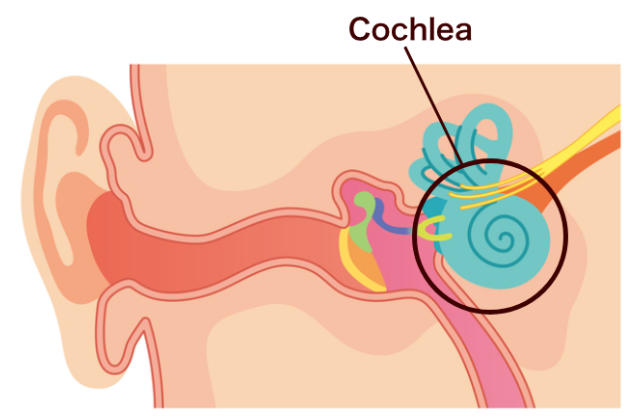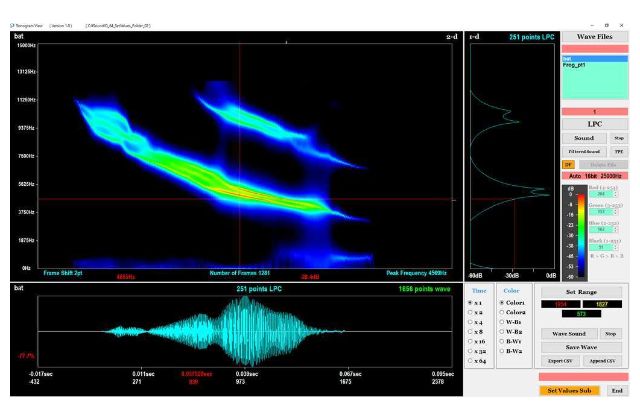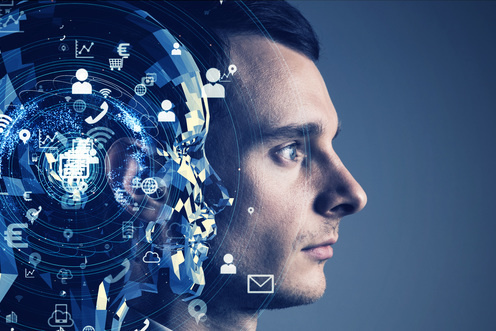About General Information
This technology is suitable for analyzing transient signals such as seismic waves and voiceprints.
It was announced in 1967 in a form used for seismic wave analysis. However, it did not spread because the amount of calculation was larger than that of FFT. Now that the computer performance has improved and the calculation processing environment has improved significantly, it is now possible to easily analyze the spectrum of LPC with this software using your PC.
It is based on a "unique mathematical algorithm" that improves on the problems of the Eugrid distance and the cosine scale.
Details are posted on the following pages. Please refer to "Features and Principles of Geometric Distance".
About Products
It is possible that WAV data is converted to "LPC spectrum" for analysis, and "pattern recognition" of spectrum images.
Pattern recognition uses the patented "Geometric Distance".
For more information on patents, see Advantages and Principle of GD.
We have a track record in the fields related to tapping sound inspection and abnormal noise detection of metals.
We have a track record in the field of concrete hammering sound inspection and abnormal noise detection of metals. This software is also used for "wildlife bark detection," which is being researched in Australia for the purpose of protecting endangered wild birds.
For details, please refer to "Papers&Patents" and "Case".
GD Similarity is a product created through joint research between industry-academia collaboration between Professor Jinnai of Nagoya Women's University and Quan Inc.
Click here for previous papers and patents.
It is possible to perform "absorption of fluctuations" and "detection of deviation", and it is possible to perform voice recognition with a "more human-like feeling" and abnormal noise detection in a "noisy environment".
We believe that this mathematical algorithm has the potential to enable computers to "recognize even closer to human senses."
For details, see "Advantages and principle of GD".
We believe that it will play an important role in computer intelligence.
By recognizing the "similar sensations" possessed by animals such as humans and dogs and cats in sight and hearing using our unique mathematical algorithm (similarity scale), we will realize the intelligence of computers. I think that will be even more possible.
Please see the TOP page for details.
"GD Similarity" is software that can be used only on Windows®.
We recommend Windows® 10 (64-bit version) as the operating environment.
First, use the free trial version and check the operability on your computer.
Sound source data is WAV only.
The only sound source data that can be used with the software is "WAV". Compressed sound sources (MP3, etc.) cannot be used.
We will ask you about the situation of the customer and propose a solution to the problem. Please contact us for more information.
In addition to being able to easily perform analysis using the "LPC spectrum", it is also possible to automate and model abnormal noise detection by combining it with a sensor device.
Please contact us for more information.
Currently, we are conducting applied research in the AI field using the already developed 1D and 2D GD and high-speed GD algorithms.
We are also waiting for applications for joint research at any time.
By utilizing pattern recognition based on "shape distance" as well as "machine learning using LPC", you can expect to improve the accuracy and function of voice recognition and image recognition.
For details, please refer to "Case".
A new similarity measure, "Geometric Distance," uses a mathematical algorithm that measures the distance between two patterns as a "distance." GD Similarity can also be applied to the imaging field.
It is also possible to utilize the features of shape distance pattern matching for image recognition.
For more information, such as applying for joint research, please contact us from "Inquiries".
We try to make proposals that meet the needs of our customers.
Please feel free to contact us.
If you would like custom-made support or introduction consulting, please contact us from "Inquiries".
About Purchase
A free trial version is available. We will do our best to make it available to as many people as possible.
Please try the free trial version and proceed to "Download".
If you have any questions, we will consider the customer's usage environment and propose the most suitable method, so please contact us from "Inquiries".
Study Room
Introduction to speech recognition
Is the computer "seeing" the audio data?
Computers convert audio into "frequency data."
The format is generally WAV or AIFF. The audio players we use also use compressed sound sources (MP3, etc.) that are made by removing "sound" data that cannot be heard by the "human ear," and are also used for music distribution.

How does the familiar AI "ear" work?
The voice recognition performance of products that are familiar to us, such as smartphones and AI speakers, has rapidly improved and is becoming more and more familiar. The voice recognition of a product requires "ears" like humans.
How does AI listen to people's voices?

Is the "ear" of AI the "eye"? Differences between how the human ear works and how the AI ear works.

Structure of the human ear

LPC Spectrum
Humans listen to "sound" by converting the "vibration" of sound into an electrical signal with an organ called the "cochlear duct" in the ear.
On the other hand, AI converts voice data (WAV, etc.) into an "image" called a spectrum and analyzes the characteristics of the image to determine it as "sound."
"AI style" hearing technique
Now let's "see" how the AI is listening.

Voice data creation
Collect sound from a microphone and converts it into "voice data".
Spectral analysis
The computer converts the "audio data" into a "spectral image".
In the spectrum image, a characteristic "frequency wave" appears for each sound.
Pattern matching (image recognition)
AI compares the characteristics of the "frequency wave" image from a large amount of data and then determines what the sound is.
Natural language processing
AI combines the sounds it hears and then determines what it means as a word.
The "ears" of AI are still developing.
Gender, dialect, and the same language are spoken differently by each person, but speech recognition needs to determine that in real time. Computers are good at fixed actions and calculations, but not good at analyzing unfixed things.
Now, if you compare it to a person, it can be said that a small child is beginning to learn words.

Get closer to people. ~The future of speech recognition~
The important thing in improving the accuracy of speech recognition is the "hearing technique" introduced earlier.
By utilizing "spectral analysis" suitable for analyzing "human voice" and further improving the accuracy of pattern matching, "sound" can be discriminated more accurately. If the "sound" can be accurately identified, the function of natural language processing can be expected to improve.
Due to various technological innovations including the improvement of computer processing speed in recent years, the appearance of robots and AI that can talk with each other is expected to be realized in the near future.
GD Similarity aims to realize "ears with human senses" in spectrum analysis and pattern matching.



